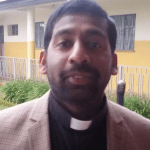In the year 1264 at the request of Pope Urban, St. Thomas Aquinas composed a beautiful hymn for the feast of Corpus Christi. The hymn is very familiar to us and it continues to inspire us to love and adore the Eucharist. The first verse says:
“I adore you by prostrating before you, Godhead here hiding
See Lord at thy service low lies here a heart
Lost all lost in wonder at the God thou art
Seeing, touching, tasting in thee are deceived
What God’s son has told me, take for truth I do
Truth Himself speaks truly”

The Second Vatican Council told us that the celebration of the Eucharist is “the source and summit of the Christian life” (LG, 11). The inexhaustible richness of this sacrament is expressed in different names like; The Lord’s Supper, The Breaking of Bread, The Holy Sacrifice, The Holy Mass, The Holy Communion.
Among these different names, here I would like to reflect on the name ‘The Holy Communion.’ In Eucharist Jesus Christ gives himself for us in love. When we eat the broken Bread and drink from the chalice we unite ourselves with the love of Jesus. This deep and enduring unity with Christ’s love is rightly called as Holy Communion. Eucharist unites us not only with Christ, but with one another. All those who experienced the deep unity with the Lord also moved to unite with fellow human beings, especially with the abandoned poor and suffering.
Jesus took the bread, gave thanks, broke it and gave to his disciples. The bread is his own life. Jesus was broken. He is broken for us and he asks us to give ourselves for others. In the other he invites us to deep communion with him and with one another in love. Therefore, from the very beginning of the church, Eucharist became the center and the pattern of life of the Church. With the strength of this bread there are multitude of holy men and women who have “broken” themselves for their brothers and sisters.
A journalist who visited Mother Theresa of Calcutta to interview her, was wonder struck with the work which Mother Teresa and her sisters were doing for the poor and suffering. He asked her, “Where do the sisters get the joy and the strength to do all these works”? Mother Teresa took him to the chapel of the convent and pointing to the Tabernacle, she said to him: “It is from there.”
About the Author:
 Fr. Binoy Puthusery, C.M. is a Vincentian priest belonging to the Southern Indian Province. He was ordained as priest on December 27, 2008 and soon after served as an assistant parish priest in Tanzania. In 2011, after two years of ministry, he was appointed as Spiritual Director to the Vincentian Sisters of Mercy, Mbinga Tanzania. He currently lives in Barakaldo (Spain), and is a teacher in the Masters in Vincentian Studies.
Fr. Binoy Puthusery, C.M. is a Vincentian priest belonging to the Southern Indian Province. He was ordained as priest on December 27, 2008 and soon after served as an assistant parish priest in Tanzania. In 2011, after two years of ministry, he was appointed as Spiritual Director to the Vincentian Sisters of Mercy, Mbinga Tanzania. He currently lives in Barakaldo (Spain), and is a teacher in the Masters in Vincentian Studies.







0 Comments